They say… 
Best beer and travel writing award 2015, 2011 -- British Guild of Beer Writers Awards
Accredited Beer Sommelier
Writer of "Probably the best book about beer in London" - Londonist
"A necessity if you're a beer geek travelling to London town" - Beer Advocate
"A joy to read" - Roger Protz
"Very authoritative" - Tim Webb.
"One of the top beer writers in the UK" - Mark Dredge.
"A beer guru" - Popbitch.

|
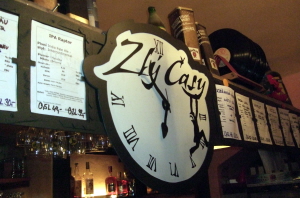 Probably the most interesting clock in Prague. Bohemia taught the world alot about brewing: now it seems the world is returning the compliment. On the simple wooden shelves of Pivkupectví, the bottle shop attached to one of Prague’s leading specialist beer pubs, Zlý Časy (Wicked Times), you’ll find an impressive range of serious craft beers from Belgium, France, Germany, the Netherlands, Scandinavia, the UK and the USA. They include selections from some of the world’s most talked about brewers: Amager, BrewDog, Mikkeller, Molen, Nøgne-Ø and Thiriez.
I wonder how easy it is to sell these beers, some of which cost Kč200 (£7, €8, $11.50) or more, in a city where you can buy a decent half litre of beer in a supermarket for Kč11 (40p, €0.45, 65¢). Helpful shop manager Dana tells me they do really well, with a core of regular customers — Czechs as well as the many visitors and expatriates in this cosmopolitan city — always on the lookout for something different and interesting.
 Crates at Pivkupectví. It’s a remarkable development on a beer scene that, alongside its home country, has had an interesting century. The Czech lands spent several past centuries under the control of Austria’s Hapsburg dynasty, its southern German-speaking culture influencing brewing as it did many other aspects of life. Within this cultural sphere a belt of brewing cities, from Munich via Vienna to Prague and České Budějovice (Budweis) perfected the techniques of modern lager brewing in the first half of the 19th century, culminating in the celebrated golden lager of Plzeň that, as pilsner, provided the increasingly degraded template for the world’s most recognised beer style.
The Czech lands emerged from the meltdown of Austria-Hungary after World War I lumped together with neighbouring Slovakia as an independent nation. Nazi Germany’s annexxation of Czechoslovakia in 1938 formed a prelude to World War II, after which the country fell under the Soviet Union’s sphere of influence for several decades, becoming a ‘communist’ state with all industry nationalised.
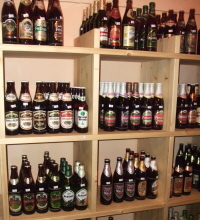 Bottle shelves at Pivkupectví. Nationalisation can take some of the credit for ensuring the preservation of traditional brewing techniques which countries on the other side of the ‘Iron Curtain’ jetissoned, but the stifling grip of Stalinist bureaucracy stunted creativity and innovation, with some breweries restricted to only one standard beer. Then in 1989 came the Velvet Revolution, soon followed by the Velvet Divorce in which the Czech Republic and Slovakia went their separate ways.
The restoration of the capitalist market and the privatisation of most of the breweries hasn’t been an entirely positive experience from a beer point of view — the multinationals, attracted by a population that drinks more beer per head than any other in the world, soon swooped in, and there’s no doubt many of the estabished brewers’ products have lost character as a result. At the same time, though, the market has opened up space for small scale innovation and niche specialities.
In recent years that space has become increasingly occupied by new breweries that see themselves as part of the international craft brewing movement. Brewers like Kocour, Matuška and Staňkův take the best of the native tradition and styles and techniques inspired by other countries. They have an uphill struggle in convincing Czechs reared for decades on standard lager that there’s more to the world of beer, and in taking on the big brewers that control much of the licensed trade, but they’re tackling the project with gusto and some success, aided immeasurably by showcases like Zlý Časy, surely one of the world’s best beer pubs.
 The unassuming entrance to Pivkupectví. Owner Jan Charvát, a former vineyard manager who’d moved into running pubs, opened Zlý Časy in 2006, down a side street in the inner city district of Nusle, Prague 4 — not unpleasant and well located for the tram network, but a long way off the very well worn tourist trail of the famously beautiful Czech capital. In appearance this is in many respects a traditional small city pub with some quirky touches, tucked away in a cellar under a residential block, simply furnished in wood and serving up the substantial local version of pub grub.
At first its beer offer was traditional too but in January 2008, encouraged by the opening of new breweries and the glaring paucity of beer showcase outlets locally, Jan expanded the beer range dramatically. In July 2010 a shop, Pivkupectví, opened next door, with what’s almost certainly the best range in the city. “I genuinely think we’re the most exciting thing about beer in Prague right now,” says Jan, and he’s probably right.
The pub stocks up to 24 changing draught beers, mainly Czech but with the occasional German, all lovingly detailed (in Czech) on information sheets above the bar and below the distinctive Zlý Časy clock (they’re keen on their clocks in this part of the world). This is supplemented by a chiller cabinet with up to 50 beers from all over, culminating when I called with 330ml bottles of BrewDog’s Sink the Bismarck at Kč2099 (£75, €86, $120)!
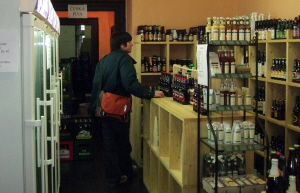 Prague-based beer writer Evan Rail chooses carefully at Pivkupectví. The shop expands the range to 500 bottled beers, neatly packed on plain wooden shelves into a relatively small space and chosen, according to Jan, by drawing on the advice of beer rating websites and “barflies”. About two thirds are Czech, with a focus on smaller brewers. The new micros are well represented, but so are some of the best of the old established independent brewers: Černá Hora, Chodovar, Ferdinand, Janáček, Náchod Primátor, Opat, Pardubický, Svijanský and Vyškov are favourites.
The Belgians are mainly solid classics (Trappists, Rodenbach, Boon Oude Geuze) supplemented by the likes of De Ranke and Struise, and there’s a short but well chosen German choice including Schlenkerla Rauchbier and several unfiltered lagers and wheat beers. Americans are those now regularly imported into Europe — Anchor, Flying Dog, Great Divide, Left Hand, Sierra Nevada. Then there are the various Dutch, Scandinavian and Scottish beer geek pleasers mentioned earlier, a number of whom have collaborated with Czech brewers. Some of this comes courtesy of Mike Cole’s Czech-based importer Odddog, established in 2009, which is now also exporting Czech craft beers to the UK.
Then there’s gift boxes, glasses, the odd bit of breweriana and a curious range of handmade Czech beer cosmetics including bubble bath to help you recreate the experience of a beer spa at home. Once a year the pub and shop stage a microbrewery festival but otherwise there are not yet events and tastings.
Jan is optimistic, with the ultimate ambition to expand the range to 1,500 beers. “The situation is getting slowly better,” he tells me. “Microbreweries like Kocour are doing very exciting things, and Czech people are finding their way to the imported beers too.” The recent joint launch by a group of Prague pubs including Zlý Časy of the Aliance PIV (Intelligent Beer Bars’ Alliance) is helping provide a more general focus for the growing scene. It looks like the interesting times for Czech brewing will continue.
Researched September/December 2010. Thanks to Evan Rail for his advice and recommendations.
Fact file
Address: Čestmírova 5, 140 00 Praha 4
Tel: +420 723 339 995
Website: www.zlycasy.eu
Hours: Shop Mon-Fri 1300-2100; Pub Mon-Thurs 1100-2330, Fri 1100-0100, Sat 1700-0100, Sun 1700-2300
Drink in? In pub but not in shop
Mail order: Not yet
 Raise a glass to Zlý Časy and Czech microbrewing. Manager’s favourites: Anything from Matuška, Struise Ignis et Flamma
Beer picks
- Bernard Sváteční Ležák 5%, Humpolec, Vysočina. Beautifully fresh and juicy bottle conditioned lager with a decent whole hop bite.
- Chodovar Zámecké Černé 4.2%, Chodová Planá, Plzeňský kraj. Soft, sweetish and caramel-tinged honestly malty dark lager.
- Kocour Weizenbock 6.6%, Varnsdorf, Ústecký kraj. Big tangy cloudy wheat beer with marmalade and spiced cake notes.
- Matuška Raptor IPA 6.2%, Broumy, Středočeský kraj. Impressive Czech interpretation of a Cascade-scented American IPA.
- Polička Záviš světlý ležák 12°5.2%, Polička, Pardubický kraj. Impressive unpasteurised premium lager with a citric, slightly oily note.
- Vyškov Jubiler 7.5%, Vyškov, Jihomoravský kraj. A fine strong celebration lager with apricottish estery hints.
Beer sellers: Zlý Časy / Pivkupectví
Top Tastings 2010
ABV: 5%
Origin: Humpolec, Vysočina, Czech Republic
Website: www.bernard.cz
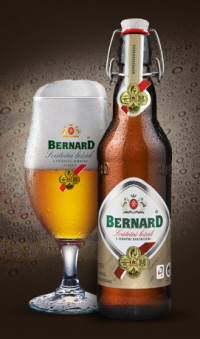 Bernard Sváteční Ležák The Bernard brewery, in the hill country between Bohemia and Moravia, traces its history to 1597 but its current reputation is strictly post-Velvet Revolution. In 1991 a team led by Stanislav Bernard bought the small, neglected and bankrupt brewery at auction and set about turning it into an example of the best kind of traditional Czech brewing practice. Expansion followed in 2001 thanks to a 50% investment from Belgian ‘new national’ brewer Duvel-Moortgat.
Crucial to the regenerated brewery’s success has been an early decision to produce only unpasteurised beer, using top quality malt and whole hops. This beer, one of the best of a very strong range, goes one stage further in being unfiltered and bottle conditioned too.
It’s a lightly hazy golden beer with a just off-white head and a fresh, fecund, lightly honeyed, malty aroma with a splash of lemon. A beautifully full, fresh and juicy palate has firm cereal notes, straw and an initially gentle burr of balancing hops which becomes quite bitter and citric in the mouth. A chewy, lightly resiny finish turns lightly peppery, but wonderfully offset by fresh fine malt. A classic.
Read more about this beer at ratebeer.com: http://www.ratebeer.com/beer/bernard-svate269ni-lezak/26766/
Beer sellers: Zlý Časy / Pivkupectví
ABV: 4.2%
Origin: Chodová Planá, Plzeňský kraj, Czech Republic
Website: www.chodovar.cz
 Chodovar Zámecké Černé Incorporating ancient cellars cut into granite and completely dominating its small village home west of Plzeň, the Chodovar brewery traces its written records back to 1634, though much of today’s structure is the result of an 1862 rebuild. It’s host to several beer related events and in 2006 brought together two Czech passions when it opened a hotel and spa, U Sládka (‘the Brewer’), incorporating beer baths and a ‘beerarium’ restaurant in a former malthouse with beer sommeliers in attendance.
Zámecké Černé (‘Black Castle’, also known as Černá Desítka, or ‘Black 10’ after its degrees of original gravity in the Plato/Balling system) is a decent, honest example of a standard Czech dark lager. It’s very dark brown, with amber highlights, a light beige head and a very malty and caramelly aroma reminiscent of malt breakfast cereals. The sweetish, biscuity, caramel-tinged palate is lightened by some spices and a slight tangy, physali note. There’s a little drying hops and toast in the finish, reminiscent of bourbon biscuits. I’ve got a soft spot for sweet, gentle beers and this one certainly hit it.
Read more about this beer at ratebeer.com: http://www.ratebeer.com/beer/chodovar-zamecke-268erne/15530/
Beer sellers: Zlý Časy / Pivkupectví
ABV: 6.6%
Origin: Varnsdorf, Ústecký kraj, Czech Republic
Website: www.pivovar-kocour.cz
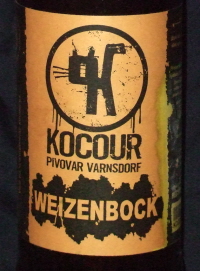 Kocour Weizenbock Another new Czech micro brewing internationally inspired craft beers alongside interpretations of indigenous lager styles, Kocour — ‘Tomcat’ — was founded by Josef Šusta and Honza Kočka in 2008 in Varnsdorf, in the far west of the country right by the German border. Honza previously worked as an air steward, through which he’d discovered the US craft beer scene.
The brewery explicity sets out to challenge Czech perceptions: according to its website, it has “committed itself to an uneasy task – to persuade domestic conservative beer drinkers that beer does not equal a chilled bottle in the fridge…that beer can go easily with gastronomy, that there is a beer for every season, for every state of mind.” The challenge begins at the label design which, as you can see, departs strikingly from tradition.
Nearby Germany also provides some inspiration, notably in this cloudy amber strong bottle conditioned wheat beer with its yellowish-white moderate head. It has a very clovy, spicy, banana-tinged aroma with a hint of furniture polish. A full, creamy palate is tangily astringent with orange marmalade and spiced cake flavours. A little alcohol makes itself felt in a dark marmalade finish that’s vivid and tangy with a sprinkling of hops and recurring clove flavours.
Read more about this beer at ratebeer.com: http://www.ratebeer.com/beer/kocour-weizenbock/114218/
Beer sellers: Zlý Časy / Pivkupectví
Top Tastings 2010
ABV: 6.2%
Origin: Broumy, Středočeský kraj, Czech Republic
Website: www.pivovarmatuska.cz
 One of a small but growing number of innovative new microbreweries challenging the dominance of straightforward pale and dark lagers in the Czech Republic, Pivovar Matuška was founded only in 2009 but has already caused ripples internationally with its eclectic range of quality beers. It’s run by Martin Matuška and his son Adam from an outhouse in the family home in a small village not far from Beroun in Central Bohemia. One of a small but growing number of innovative new microbreweries challenging the dominance of straightforward pale and dark lagers in the Czech Republic, Pivovar Matuška was founded only in 2009 but has already caused ripples internationally with its eclectic range of quality beers. It’s run by Martin Matuška and his son Adam from an outhouse in the family home in a small village not far from Beroun in Central Bohemia.
Martin has worked abroad including in the US, and the influence shows: besides more familar lager styles the brewery produces gems like this American-tinged IPA, although the brewery insists it owes as much to English inspiration.
It’s a pretty amber colour with an unfiltered haze and a thick, creamy yellowish head. There’s telltale grapefruit notes of Cascade on the aroma, and the thick malty palate is very soft and lightly chewy, with a gentle thistly and citrus note. A spicy finish has hints of mint and grapefruit and a lengthy, soothing quality that seems typically Czech.
Read more about this beer at ratebeer.com: http://www.ratebeer.com/beer/matuska-raptor-ipa/123352/
Beer sellers: Zlý Časy / Pivkupectví
ABV: 5.2%
Origin: Polička, Pardubický kraj, Czech Republic
Website: www.pivovar-policka.cz
 Poličské Záviš světlý ležák 12° This intriguing brewery in the birthplace of composer Bohuslav Martinů traces its history back to 1517 when it was founded by a cooperative of townspeople, thus its full title Měšťanský pivovar v Poličce, ‘Polička town brewery’. These days its carefully made beers bear EU Protected Designation of Origin logos on their attractive art nouveau labels.
This unpasteurised lager pours a pale gold with a fine white head and a good, lively bead. A grassy floral hop aroma has slightly sweaty tones, with a floury malt note. The palate is very crisp and slightly tangy with bitterish, quite complex herbal hops and a touch of citrus, well supported by a rich, creamy texture. A citric, slightly oily note tinges the finish, which is notably bitter for the style with a lingering pursing quality. An impressive example of its style.
Read more about this beer at ratebeer.com: http://www.ratebeer.com/beer/poli269ske-zavis-sv283tly-lezak-12o/13068/
Bohuslav Martinů
Beer sellers: Zlý Časy / Pivkupectví
ABV: 7.5%
Origin: Vyškov, Jihomoravský kraj, Czech Republic
Website: www.pivovyskov.cz
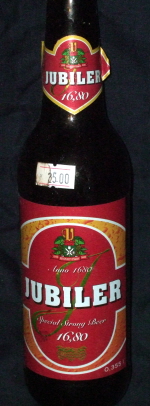 Vyškov Jubiler In the historic town of the same name in a rural part of southern Moravia once populated by German-speaking farmers, the Vyškov brewery was founded in 1680 by the bishop of Olomouc, remaining in church hands until well into the 19th century. Like most Czech breweries it was nationalised after World War II and, it appears, is now one of the few to remain in state hands. There have been various unsuccessful attempts to find a buyer, as a result of which it’s been under threat of closure. The most recent invitation to tender for brewery and brands was issued in December 2010. Losing it would be a great shame as it produces an interesting variety of beers including some unusual specialities.
Jubiler is one of these — according to Czech beer expert Evan Rail it’s arguably the best strong pale lager in the country. It was originally brewed to celebrate the brewery’s 325th anniversary, to an original gravity of 16.80 in the old Plato (Balling) scale, commemorating the foundation date. It’s a gold beer with a little white head, and obvious alcohol on the perfumed, estery, varnish-tinged aroma, along with an odd dry spicy note. A firm malty palate is soft but dry with floral, citric and slighty apricottish flavours, with some light hops emerging over firm, fruity malt. A warming malty swallow leads to a finish that rapidly turns pursingly dry and firm, with powdery hops on the tongue. Sadly pasteurised but otherwise a beer of some authority.
Read more about this beer at ratebeer.com: http://www.ratebeer.com/beer/vyskovske-jubiler/47916/
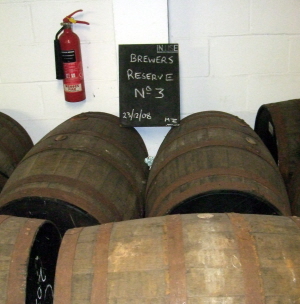 What better image of London beer? Fuller's Brewers Reserve No 3 maturing in the spare spaces of the Griffin brewery, spotted in January 2011. Don’t you just hate finding websites with grandiose mission statements that haven’t been updated for many months? Me too. I should therefore apologise profusely for leaving this site in just such a state of neglect recently. However I have a very good excuse.
Since November I’ve been hard at work researching and writing my first book, London’s Best Beer Pubs and Bars, due to be published by CAMRA Books this July. The book is intended to provide a one stop shop for anyone with more than a passing interest in beer, resident or visitor, who wants to explore London’s already decent and rapidly improving beer scene. More than just a pub guide, it’s also a celebration of the renaissance of craft brewing in London and the capital’s increasingly vibrant community of specialist beer pubs and bars.
The biggest section of the book is a directory of places to drink — mainly pubs of various kinds, but also bars, the best beer shops and a few other places ike social clubs. They’ve been chosen to give a broad picture of the wide variety of top quality beer available in London — not only cask, but bottled and imported craft beers too. Then there’s an extensive section on beers widely available in London, not only from the UK but from some other countries, with brief tasting notes.
The London brewers are given enhanced coverage, and deservedly so, as this is one of the most exciting stories the book has to tell. When Young’s quit Wandsworth in 2006 they left behind only seven commercial breweries, of which only two were substantial producers of craft beer. But since early 2007 another six have appeared, and many of the existing brewers have developed and grown substantially. The quality too is impressive — as one brewer told me, there’s little point in brewing in London unless you can at least match the standard of Fuller’s. Some of the new brewers are truly extraordinary, like the Kernel, recently listed as one of the top five newcomers of 2010 by ratebeer.com. While we’re still some way from reclaiming London’s title as the brewing capital of the world, we certainly don’t have to hang our heads in shame anymore when we’re asked about our local breweries.
London’s former glories are also covered, with plenty of background on brewing, history and geography to set the context, a roundup of beer styles and my own take on the obligatory ‘How beer is brewed’ article. All in all I’m very pleased with the book, and delighted to have been offered such a timely opportunity.
However producing such a book from scratch in a very short time frame while also holding down a full time job has proved something of a challenge. I negotiated a four week sabbatical from my day job, but that hasn’t been enough to complete the work, so I’ve been working on the book in my spare time too. I’ve pretty much worked every waking hour not taken up with the necessities of life every day between early November and early March, cancelling all but the most pressing existing commitments.
Extensive research accounted for much of the time. It may shock you to discover that some writers compile books of this kind exclusively by telephone and internet. I felt I owed it to my readers to visit everywhere that was included, even places I was familiar with, just to remind me. Between 13 November and 8 February I visited practically every place on my original shortlist of 297, of which just over 250 have ended up in the book. It sounds like a riproaring pub crawl, but consider visiting 21 pubs in a 14-hour day with no more than a few sips of a half in any of them and you might take a different view. More time was spent travelling than in the pubs themselves — by every mode other than my own car, including bus, tube, train, tram, Boris bike and, just once, a taxi to extricate me from the rural extremities of the London Borough of Bromley. I’m grateful for being a keen and fast walker as this provided the most convenient mode for most of the trips. Of course there are worse jobs, but it’s certainly hard work!
While exhausting, it’s also been a fascinating and rewarding process. For all the gloom that seems to dominate parts of the industry, it’s great to see so many licensees doing well by being imaginative, enthusiastic and community focused as well as making the best of their beer offer. It’s also really encouraging to see a notably younger and very savvy crowd out enjoying fine beer in new pubs and bars like Cask, the Dean Swift, the Euston Tap, the Jolly Butchers, Mason & Taylor and the awesome Southampton Arms.
As the publication date approaches, I’ll be giving the book more exposure on this site. Inevitably a book like this goes out of date immediately the last word is written so after publication I aim to post updates on these pages.
Meanwhile, I’ll be back to some of those pubs myself for more than just a sip of a half!
Keep track of the latest news on the London page.
First published in Beers of the World June 2008
 Beermania, Brussel-Bruxelles Browse the impressive framed collection of international press coverage on display at Beermania and you’ll find that most journalists who visit Brussels’ best specialist beer retailer write at least as much about the proprietor as his shop. Not surprisingly, since Nasser Eftekhari is a remarkable character: passionate, knowledgeable, articulate and outspoken in his opinions. And then there is the intriguing question of how a political refugee from Tehran came to be one of the leading international ambassadors for the Great Beers of Belgium.
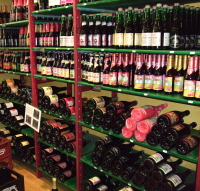 Inside Beermania, Brussel-Bruxelles In fact Nasser’s family were Zoroastrians with no taboo against alcohol, and he became interested in home brewing while still in Iran. Things became difficult when Khomeini came to power and Nasser fled the country in the early 1980s, eventually arriving in Brussels where he developed his passion for the local beer. Beermania had already been open for three years when he bought it in 1986 from a customer of the pub where he was working.
Since then Nasser and his wife Natasha have built the shop up into an essential stop for international beer hunters, who are well rewarded for the effort of heading off the tourist track to the vibrant, cosmopolitan and increasingly yuppiefied community of Ixelles. Around 400 hand-picked beers are stocked, all of them Belgian except for the Dutch La Trappe beers that complete a comprehensive Trappist range. There are particularly strong collections of abbey beers, lambics and rare Wallonian microbrews, and few big commercial brands. Aged beers, big bottles, gift packs and selection boxes, glassware and beer books are also available. Bar area, Beermania, Brussel-Bruxelles
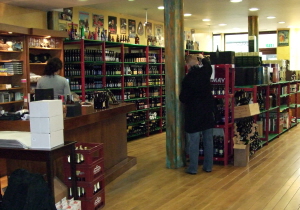 Inside Beermania, Brussel-Bruxelles Last year Nasser used his knowledge of his customers’ tastes to launch his own beer, Mea Culpa, presented in a dramatic glass with a swan-necked stem, contract-brewed at an unidentified brewery. Everything can be sampled for a slightly higher price in the beautiful tasting area with fine oak floors and furniture: in typical attention to detail, the state of the art fridges have had their motors removed to the cellar so the noise won’t disturb the ambience. The shop also hosts regular jazz gigs, and cuisine à la bière events are planned.
Nasser will happily share his expert knowledge of the Belgian beer scene in fluent French, Dutch or English. “The life of all Belgian breweries changed overnight in the late 1970s when the world discovered Belgian beers through Michael Jackson,” he says. “Beer orders rained down from around the world and of course we were not ready for this success. Brewers expanded too fast, got into debt and crashed down. The survivors reduced the quality of the beers by things like reducing fermentation time. Now the small brewers are struggling and for the big brewers, with their marketing managers and export managers, beer is a business, not a passion. On the other hand, American beers are getting better and better – a big danger for Belgian brewing. Meanwhile, I’m planning to keep going as the shop window for all good breweries in Belgium!”
Fact file
 Mea Culpa glass, Beermania, Brussel-Bruxelles Address: Waversesteenweg/chaussée de Wavre 174-176, 1050 Elsene-Ixelles, Brussel-Bruxelles
Phone: +32 (0)2 512 1788
Web: www.beermania.be
Hours: Mon-Sat 1100-2200
Drink in? Yes
Mail order: Yes, worldwide through website
Manager’s favourites: Mea Culpa, Westvleteren Blond, Orval
Beer picks
-
3 Fonteinen Oude Kriek 5%, Beersel, Vlaams-Brabant, Vlaanderen. Stunning cherry lambic from classic Payottenland café, lanolin aroma and dry tart palate softened by fine fruit, elegant subtle cherry finish.
- Blaugies La Moneuse 8%, Blaugies, Hainaut, Wallonie. Dry golden triple with perfumed orange pith and woody hazelnute palate, and warming bitter herb and exotic fruit finish.
- Bocq St Feuillien Brune 7.5%, Purnode, Namur, Wallonie. Rich, abbey brown with old books, mandarin, chocolate, glace cherries, liquorice, dates and vermouth in complex palate and long layered finish.
- St Hélène Djean d’Mady 5.5%, Èthe, Luxembourg, Wallonie. Delightful rustic amber ale from Gaume region, with toasty gooseberry fool notes and a soft, dryish sappy finish.
- Van Steenberge Beermania Mea Culpa Blond 6.5%, Ertvelde, Oost-Vlaanderen. Beer Mania’s own brand, a soft, seedy, lightly fruity blond with a dry quenching vanilla-tinged citric finish.
Beer sellers: Beermania
ABV: 8%
Origin: Blaugies-Dour, Hainaut, Wallonie
 Blaugies La Moneuse Though the centre of gravity of Belgian speciality brewing is skewed towards the Dutch-speaking north, some of the most interesting and rustic Belgian beers come from small rural breweries in the French-speaking south of the country. Consider Blaugies, a brewery in a garage in the village of the same name, part of the commune of Dour in the west of Hainaut province, right by the French border. Couple Pierre-Alex Carlier and Marie-Robert Pourtois started it using pots, pans and advice from a friendly local brewer in 1988, and it’s since become the family business, with much of the production going to export.
Blaugies offers some intriguing specialities such as a a saison brewed with spelt and a wheat beer flavoured with figs. The core brand remains the brewery’s first beer, the saison-style deep golden Moneuse, named for a late 18th century ancestor, AJ Moneuse, a notorious local gang leader and bandit. Like the rest of the range it’s bottle conditioned in both 375ml and 750ml bottles with wired corks.
The combination of a lively condition and a thick sediment cloud the beer under a thick white head. The aroma is relatively restrained, with spicy and creamy light malt, and there’s a dry, slightly woody palate developing chocolate, hazelnut, herbs and stalky perfumed orange pith. A hoppy, herby finish gets dry, woody and warming with bitter herbs and exotic fruit.
Read more about this beer at ratebeer.com: http://www.ratebeer.com/beer/la-moneuse/9351/
|
Cask  This pioneering new book explains what makes cask beer so special, and explores its past, present and future. Order now from CAMRA Books. Read more here. This pioneering new book explains what makes cask beer so special, and explores its past, present and future. Order now from CAMRA Books. Read more here.
London’s Best Beer  The fully updated 3rd edition of my essential award-winning guide to London’s vibrant beer scene is available now from CAMRA Books. Read more here. The fully updated 3rd edition of my essential award-winning guide to London’s vibrant beer scene is available now from CAMRA Books. Read more here.
|






















